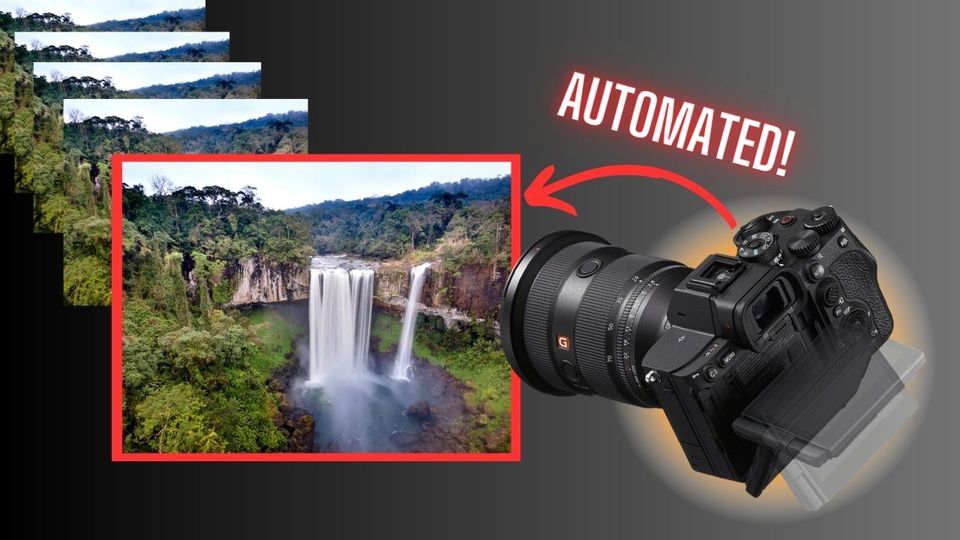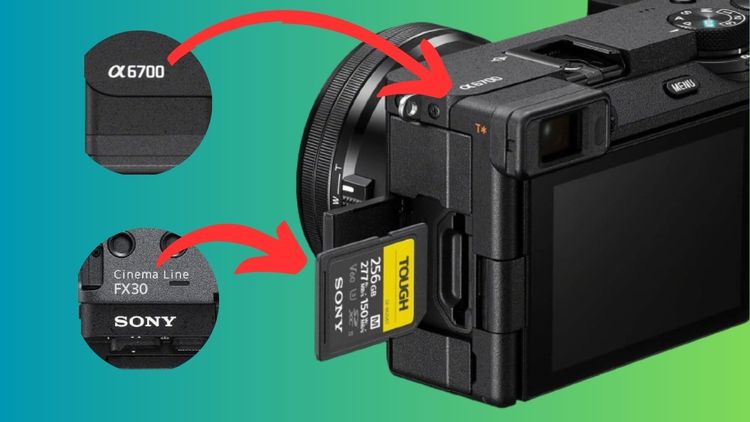20 Best Cameras With Built in Focus Stacking (In-Camera Focus Bracketing - Automated!)

Hey fellow shutterbug,
Are you tired of manually adjusting your camera's focus for every shot?
Do you find it tedious and time-consuming to ensure that every element in your shot is in focus?
If so, we have the solution for you. Introducing 20 of the best cameras with built-in focus bracketing, allowing you to automate the process and capture every detail with ease.
Say goodbye to the hassle of manual focus adjustments and hello to a streamlined photography experience.
Keep reading to discover the best ones for you!
List of Cameras With Built-In Focus Bracketing Feature
Looking for a camera that can do focus bracketing internally? Look no further! Here are some top picks for cameras with built-in focus bracketing feature:
- Sony A7R V - Our Top #1 Pick Best Camera With Focus Bracketing
- Olympus OM-D E-M1 Mark III - Professional-grade Camera With Excellent Focus Stacking
- Panasonic Lumix GH5 (Mark II) - Budget-friendly Option With Focus Bracketing
- Fujifilm X-Pro3 - Stylish Camera For Excellent Image Quality And Focus Stacking
- Nikon D850 - Best Full-frame DSLR Camera With Focus Bracketing
Our top recommendation is the Sony A7R V, which boasts impressive features and capabilities for high-quality photography.
Sony A7R V (Our Top #1 Pick!)
With its built-in focus bracketing function and dual-format card slots, the Sony A7R V is a top-of-the-line camera that allows photographers to capture sharp images with maximum depth of field.
The camera's focus bracketing function is selected as a Drive mode, and you can choose the step-width between the different focus distances and the number of shots it takes (up to 299).
This feature is especially useful for photographers who want to achieve sharpness and detail throughout the entire image, particularly in landscape and macro photography.
In addition to its focus bracketing function, the Sony A7R V boasts an impressive autofocus system that allows you to focus on the right areas of your scene with ease.
The camera has a 61-point focal-plane phase-detection AF system, which includes 567 phase-detection AF points covering approximately 74% of the image area.
The AF system is fast, accurate, and reliable, making it perfect for capturing fast-moving subjects or shooting in low light conditions with higher resolution.

Best Camera With Built-In Focus Bracketing To Capture Beautiful Stacked Images
Sony Alpha 7R V Full-Frame Mirrorless Interchangeable Lens Camera
Product Specs:
- 61-megapixel full-frame sensor
- 567 phase-detection AF points
- Dual-format card slots: UHS-II SD cards or Sony's small CFexpress Type A cards
- 5-axis in-body image stabilization
- 10 fps continuous shooting
- 4K video recording
- Wi-Fi and Bluetooth connectivity
Pros - Why We Love It
✅ Built-in focus bracketing function
✅ Impressive autofocus system
✅ Dual-format card slots
✅ High resolution sensor
✅ In-body image stabilization
✅ 4K video recording
Cons - Consider Before Buying
⛔ Expensive price point
⛔ Limited battery life
⛔ No built-in flash

Olympus OM-D E-M1 (firmware version 4.0)
The Olympus OM-D E-M1 (firmware version 4.0) offers a range of advanced features that make it a versatile and reliable camera for capturing sharp and detailed images.
One of its standout features is the built-in focus bracketing, which allows you to take multiple shots at different focus distances and blend them together later in post-processing to create a single image with greater depth of field.
Here are four reasons why this feature makes the E-M1 a great camera for photographers:
- Ideal for macro photography: The focus bracketing feature allows you to capture more detail and create sharper images when shooting up close.
- Great for landscape photography: The E-M1's focus bracketing feature allows you to capture more detail in the foreground, middle ground, and background, and blend them together to create a single image with greater depth of field.
- Saves time in post-processing: By taking multiple shots at different focus distances, you eliminate the need for manual focus stacking in post-processing, saving you time and effort.
- Easy to use: The E-M1's focus bracketing feature is easy to use and can be accessed through the camera's menu, making it accessible to photographers of all levels.
Overall, the Olympus OM-D E-M1 (firmware version 4.0) is a great choice for photographers who want to capture sharp and detailed images with maximum depth of field.
With its built-in focus bracketing feature, the camera makes it easy to take multiple shots at different focus distances and blend them together later in post-processing, allowing you to create stunning images with ease.
Olympus OM-D E-M5 Mark III
You'll love how the Olympus OM-D E-M5 Mark III brings your images to life with its built-in feature that effortlessly captures multiple shots at different focus distances for maximum depth and sharpness.
This feature is called focus bracketing, and it allows you to take a series of shots with different focus points that can later be combined into a single image with greater depth of field.
The E-M5 Mark III is a versatile camera that is compatible with a wide range of lenses, including those that are compatible with the focus bracketing feature.

Best Retro-Style Camera With Built-In Focus Stacking For Photography Pros
OLYMPUS OM-D E-M5 Mark III Body Silver
To give you a better idea of how focus bracketing works, here's a table that shows how a sequence of images with different focus points can be combined to create a single image with greater depth of field:
| Image with focus point | Combined image |
|---|---|
| Image 1: Foreground in focus | Combined image: Foreground in focus, background blurry |
| Image 2: Middle ground in focus | Combined image: Foreground and middle ground in focus, background blurry |
| Image 3: Background in focus | Combined image: All areas in focus |
As you can see, focus bracketing can be a powerful tool for photographers who want to create images with maximum depth of field and sharpness.
With the Olympus OM-D E-M5 Mark III, this feature is built-in and easy to use, making it a great option for photographers who want to take their images to the next level.
Olympus OM-D E-M5 Mark II (firmware version 4.0)
Get ready to capture stunning images with maximum depth and sharpness using the versatile and durable Olympus OM-D E-M5 Mark II, now with firmware version 4.0.
This update brings numerous features to the camera, including focus-stacking, which enables you to capture multiple shots at different focus distances and blend them together in-camera to create a single image with greater depth of field.
With the E-M5 Mark II's built-in focus bracketing and focus-stacking features, you can now achieve the perfect level of sharpness and detail in your photos.
Whether you're shooting macro photography or landscape photography, this camera has got you covered with its ability to capture stunning close-ups.
Plus, with its compact, weather-sealed construction, you can take it with you anywhere and capture incredible images in any environment.
So, if you want to take your photography to the next level and capture images that truly stand out, the Olympus OM-D E-M5 Mark II with firmware update version 4.0 is the camera for you.
Olympus OM-D E-M1X
Now, if you're looking for a camera that can take your focus bracketing game to the next level, the Olympus OM-D E-M1X is definitely worth considering.
This camera has a built-in focus bracketing feature that allows you to take multiple shots at different focus distances, which can then be combined later in post-processing to create a single image with greater depth of field.
With this feature, you can capture stunning images with sharp focus from foreground to background, which is especially useful in macro photography and landscape photography.
But that's not all the E-M1X has to offer.
This camera is also incredibly versatile and durable, with a built-in battery grip and robust weather sealing that can withstand harsh environments.
It has world-leading image stabilization and AI-based Intelligent Subject Detection AF, making it easier to capture sharp images in a variety of shooting situations.
Plus, with its handheld ultra-high resolution shooting mode, you can capture images with incredible detail and resolution.
Overall, the Olympus OM-D E-M1X is a great tool for photographers who want to take their focus bracketing game to the next level and capture stunning images with maximum depth of field and sharpness.
Olympus OM-D E-M1 Mark II
If you're a photographer looking for a versatile camera that can capture stunning images with maximum depth of field and sharpness, the Olympus OM-D E-M1 Mark II is a great choice.
This camera features a built-in focus bracketing function, which allows you to take multiple shots at different focus distances and combine them later in post-processing to create a single image with greater depth of field.
In addition to focus bracketing, the Olympus OM-D E-M1 Mark II is also compatible with focus stacking.
This technique involves capturing multiple shots at different focus distances and blending them together in-camera to create a single image with even greater depth of field.
This camera is a great option for macro photography, as it allows you to capture more detail and create sharper images.
It is also ideal for landscape photography, as the focus bracketing feature enables you to capture more detail in the foreground, middle ground, and background, and blend them together to create a single image with exceptional depth of field.
| Benefits of Olympus OM-D E-M1 Mark II | How it Helps Photographers |
|---|---|
| Built-in focus bracketing | Allows you to take multiple shots at different focus distances and combine them later in post-processing to create a single image with greater depth of field |
| Focus stacking | Enables you to capture multiple shots at different focus distances and blend them together in-camera to create a single image with even greater depth of field |
| Class-leading continuous shooting performance | Makes it easy to capture fast-moving subjects |
| Extraordinary in-body image stabilization system | Allows handholding at unprecedented shutter speeds, resulting in sharper images |
Overall, the Olympus OM-D E-M1 Mark II is a highly capable camera that can handle a wide range of photography styles.
Its focus bracketing and focus stacking features make it an excellent choice for photographers who want to create images with exceptional depth of field and sharpness.
With its impressive build quality, excellent image quality, and abundance of features, this camera is sure to impress even the most discerning photographers.
Panasonic G90/G95
You'll love the versatility and quality of the Panasonic G90/G95 camera. It has a built-in focus bracketing feature and 5-axis Dual I.S. 2 image stabilization system, which allow you to capture stunning, detailed images.
With the G90/G95, you can take multiple shots at different focus distances and combine them in post-processing to create a single image with maximum depth of field.
Here are a few more reasons why the Panasonic G90/G95 is a great camera for photographers:
- The 20.3MP Live MOS sensor and Venus Engine processor work together to produce high-quality images with excellent detail and color accuracy.
- The camera's 5-axis Dual I.S. 2 image stabilization system compensates for up to approximately 5 stops of camera shake, making it easier to capture sharp images in low light or when using longer focal lengths.
- The G90/G95 is compatible with a wide range of lenses, including those that are compatible with the focus bracketing feature.
- The camera has a durable, weather-sealed construction that makes it suitable for use in a variety of environments.
Overall, the Panasonic G90/G95 is a great camera for photographers.
Its built-in focus bracketing feature and 5-axis Dual I.S. 2 image stabilization system make it a versatile and high-quality option for a wide range of photography styles.
Panasonic GX9
Now that you have learned about the Panasonic G90/G95, it's time to move on to another great camera from Panasonic that is perfect for photographers looking to create images with maximum depth of field – the Panasonic GX9.
This camera has a built-in focus bracketing feature that allows you to take multiple shots at different focus distances, which can then be combined later in post-processing to create a single image with greater depth of field.
To give you a better idea of what focus bracketing is and how it works, here is a table that compares it to traditional depth of field techniques:
| Traditional Depth of Field | Focus Bracketing |
|---|---|
| Requires adjusting aperture to increase depth of field | Takes multiple shots at different focus distances |
| Limits creative options as aperture affects exposure and bokeh | Allows for more creative control as aperture can be adjusted independently |
| Results in loss of detail in out-of-focus areas | Results in a single image with greater depth of field and sharpness |
| May require post-processing to enhance sharpness | Can be used in post-processing to create a single image with maximum sharpness |
| Works best for static subjects | Works best for static subjects, but can also be used for some moving subjects |
With the Panasonic GX9 and its built-in focus bracketing feature, you can take your photography to the next level by creating images with greater depth of field and sharper detail.
Plus, with its compact and well-made body, it's easy to take with you on the go and experiment with different creative techniques.
Panasonic G9
Get ready to take your images to the next level with the Panasonic G9.
This camera is a great option for photographers who want maximum depth of field and sharpness, thanks to its built-in focus bracketing feature.
Focus bracketing involves taking multiple shots at different focus distances, which can then be combined later in post-processing to create a single image with greater depth of field.
With the G9, you can easily access this feature and produce stunning images with ease.
Another standout feature of the G9 is its 5-axis Dual I.S. 2 image stabilization system.
This system can compensate for up to approximately 6.5 stops of camera shake, making it easier to capture sharp images in low light or when using longer focal lengths.
The camera's weather-sealed construction also makes it a great option for outdoor and action photography.
Overall, the Panasonic G9 is a versatile camera that is perfect for a wide range of photography styles.
Its focus bracketing feature and image stabilization system make it a great choice for photographers looking to take their images to the next level.
Fujifilm X-Pro3
If you're a fan of classic film cameras, the Fujifilm X-Pro3's unique design and hybrid viewfinder will transport you back to a bygone era while still delivering high-quality images and built-in focus bracketing.
The camera's hybrid viewfinder allows you to switch between an optical viewfinder and an electronic viewfinder, giving you more flexibility and ease when composing your shots in various shooting situations.
Additionally, the Fujifilm X-Pro3 has a durable, weather-sealed construction that makes it suitable for use in a variety of environments.

Best Fujifilm With In-Camera Focus Bracketing For Photography
Fujifilm X-Pro3 Mirrorless Digital Camera - Dura Silver (Body Only)
Its built-in focus bracketing feature allows you to take multiple shots at different focus distances, which can then be combined in post-processing to create a single image with greater depth of field.
With its 26.1MP X-Trans CMOS 4 sensor and X-Processor 4, this camera produces high-quality images with excellent detail and color accuracy.
Whether you're into street photography or documentary photography, the Fujifilm X-Pro3 is a versatile camera that can deliver outstanding results for a wide range of photography styles.
Panasonic GH5 / GH5S
You'll love the Panasonic GH5 / GH5S for its exceptional image quality, versatile features, and built-in focus bracketing capability, making it a great choice for both video and stills photography.
The GH5 has a 20.3MP Live MOS sensor and Venus Engine processor, producing high-quality images with excellent detail and color accuracy.
Plus, with the 5-axis Dual I.S. 2 image stabilization system, you can capture sharp images in low light or when using longer focal lengths.

Best Panasonic Camera With In-Camera Focus Stacking For Photographers
Panasonic LUMIX GH5M2, 20.3MP Mirrorless Micro Four Thirds Camera with Live Streaming, 4K 4:2:2 10-Bit Video, Unlimited Video Recording, 5-Axis Image Stabilizer DC-GH5M2
Here are two reasons why the Panasonic GH5 / GH5S should be your next camera choice:
- Versatility: The GH5 / GH5S is compatible with a wide range of lenses, including those that are compatible with the focus bracketing feature. You can create images with maximum depth of field and sharpness, perfect for landscape or macro photography. Additionally, the camera's weather-sealed construction makes it suitable for use in a variety of environments, making it a great option for outdoor and action photography.
- Special Post Focus Mode: The GH5 / GH5S has a special Post Focus mode, which uses its 4K video and focus bracketing features together to shoot and stack a burst of images into a single image with greater depth of field. This feature allows you to experiment with different focus points after the shot has been taken, giving you more creative freedom in post-processing.
Whether you're a professional videographer or a stills photographer, the Panasonic GH5 / GH5S is a great camera choice for those looking to create innovative and high-quality images.
Panasonic GX800 / GX850
With its compact design and advanced image stabilization system, you can easily capture sharp and detailed images with the Panasonic GX800/GX850.
This entry-level mirrorless camera features a 16MP Live MOS sensor and Venus Engine processor that work together to produce high-quality images with good detail and color accuracy.
Additionally, the camera's 5-axis Dual I.S. image stabilization system can compensate for up to approximately 4 stops of camera shake, making it easier to capture sharp images in low light or when using longer focal lengths.
One of the key features of the Panasonic GX800/GX850 is its built-in focus bracketing.
This allows you to capture images with maximum depth of field and sharpness.
This feature works by taking a series of images at different focus distances and then combining them together to create a single image with greater depth of field.
The camera is also compatible with a wide range of lenses, making it a versatile tool for photographers who want to experiment with different focal lengths and compositions.
With its compact size and user-friendly interface, the Panasonic GX800/GX850 is a great option for photographers who want to explore the creative possibilities of focus bracketing without having to invest in additional equipment.
Panasonic G80/G85 and Panasonic G7
You can capture stunning images in any environment with the durable and versatile Panasonic G80/G85 and Panasonic G7 mirrorless cameras.
Both cameras are equipped with a 5-axis Dual I.S. image stabilization system that compensates for camera shake up to 5 stops (G80/G85) or 4 stops (G7), making it easier to capture sharp and detailed images in low light or when using longer focal lengths.
In addition, both cameras feature a special Post Focus mode that uses 4K video and focus bracketing features to shoot and stack a burst of images into a single image with greater depth of field.
The G80/G85 and G7 are great options for photographers who want to create images with maximum depth of field and sharpness, with a wide range of compatible lenses, including those that support focus bracketing.
Whether you're shooting everyday photography or videography, these cameras provide versatility and durability for all your needs.
Panasonic GX880
Now that you've learned about the Panasonic G80/G85 and G7, let's move on to the Panasonic GX880 and its built-in focus bracketing feature. But first, have you ever heard of focus stacking in photography?
Focus stacking is a technique used in photography to achieve greater depth of field by combining multiple images with different focus points into one final image.
This is particularly useful for macro photography or any situation where you want to capture a subject with a shallow depth of field, but still want the entire subject in focus.
With the Panasonic GX880's focus bracketing feature, you can easily shoot a burst of images with different focus points and then stack them using software to create a final image with greater depth of field.
This is a great tool for photographers who want to take their images to the next level and achieve sharper, more detailed images.
Canon EOS RP
If you're in the market for a versatile and portable camera that delivers high-quality images and video, the Canon EOS RP is a great option to consider.
Not only does this full-frame mirrorless camera have a compact and lightweight design, but it also boasts impressive features.
One standout feature of the EOS RP is its built-in focus bracketing capability, which allows photographers to capture a series of images with different focus points and then stack them in software to create a final image with greater depth of field.
Additionally, the camera's Dual Pixel CMOS AF system with 4,779 manually selectable AF points makes it easy to achieve accurate focus.
The vari-angle touchscreen LCD and 4K video recording capability offer even more versatility for photographers and videographers alike.
With its compatibility with both RF and EF/EF-S lenses, the Canon EOS RP is a versatile and powerful camera option for any photography style.
- 26.2MP full-frame CMOS sensor and DIGIC 8 image processor
- Dual Pixel CMOS AF system with 4,779 manually selectable AF points
- Built-in focus bracketing capability for greater depth of field
Canon EOS R5
With its 45MP full-frame CMOS sensor and 5-axis in-body image stabilization, the Canon EOS R5 is a powerful tool for capturing sharp and detailed shots in any lighting condition.
The camera's built-in focus bracketing feature allows you to take a series of shots with different focus points, which can then be stacked in software to create a final image with greater depth of field.
This is particularly useful for landscape and macro photography, where you want to capture as much detail as possible in the foreground and background.
The EOS R5 also features a Dual Pixel CMOS AF II system with 5,940 manually selectable AF points, making it easy to achieve accurate focus on your subject.
Additionally, the camera has a 3.2-inch vari-angle touchscreen LCD and a 5.76 million dot OLED electronic viewfinder, allowing you to compose your shots from a variety of angles.
With its 4K video recording capability and ability to shoot 8K RAW video, the EOS R5 is a great option for both photographers and videographers who want the highest level of performance and capabilities.
Canon EOS R6
The Canon EOS R6 offers high-performance capabilities at a more affordable price point, making it a versatile option for photographers and videographers who want to capture sharp, detailed shots in any lighting condition.
Here are some key features that make the EOS R6 a great camera for your photography needs:
- Dual Pixel CMOS AF II system with 6,072 manually selectable AF points for accurate focus
- Built-in focus bracketing feature that allows you to capture a series of images with different focus points and stack them in software to create a final image with greater depth of field
- 3-inch vari-angle touchscreen LCD and a 3.69 million dot OLED electronic viewfinder for easy composition from a variety of angles
- 12 fps mechanical shutter and up to 20 fps electronic shutter for capturing fast-moving subjects
- 5-axis in-body image stabilization system that compensates for camera shake up to 8 stops, making it easier to capture sharp images in low light or when using longer focal lengths
Whether you're a photographer or videographer, the Canon EOS R6 has all the features you need to capture stunning shots and footage.
Its full-frame sensor and DIGIC X image processor produce high-quality images with good detail and color accuracy, while features like 4K video recording and the ability to use both RF and EF/EF-S lenses make it a versatile option for any photography style.
Nikon D850
Boasting a durable magnesium alloy and carbon fiber build, the Nikon D850 is a versatile camera option for photographers and videographers alike.
The camera has a 45.7MP back-side illuminated CMOS sensor and EXPEED 5 image processing, resulting in high-quality images with excellent detail and color accuracy.
The D850 has a 153-point autofocus system, borrowed from the pro-sports focused D5, making it easy to achieve accurate focus.
One of the most impressive features of the D850 is its built-in focus bracketing, which allows photographers to capture a series of images with different focus points.
These images can then be stacked in software to create a final image with greater depth of field.

Best DSLR Camera With Built-In Focus Stacking For Photography
Nikon D850 FX-Format Digital SLR Camera Body
The camera also has a 3.2-inch tilting touchscreen LCD and a 0.75x optical viewfinder, making it easy to compose shots from a variety of angles.
With its 7 fps continuous shooting speed (which can be increased to 9 fps with the optional battery grip) and 4K UHD video recording capability, the D850 is a great option for both photographers and videographers who need a camera that can withstand harsh conditions.
Nikon D810
Now that you know about the Nikon D850, let's talk about the Nikon D810 and its built-in focus bracketing feature.
Have you ever wished you could capture a scene with greater depth of field, but struggled to achieve sharp focus throughout the entire image?
That's where focus stacking comes in.
Focus stacking is a technique where you capture a series of images with different focus points, then stack them in software to create a final image with greater depth of field.
The Nikon D810's built-in focus bracketing feature makes this process easy - simply set the focus steps and number of shots, and the camera will capture a series of images with different focus points.
Then, you can use software such as Adobe Photoshop to combine the images and create a final image with greater depth of field.
This technique is especially useful for landscape photography, macro photography, and any other situation where you want to capture a scene with both foreground and background elements in sharp focus.
With the Nikon D810's built-in focus bracketing, you can achieve stunning images with greater depth of field and sharper focus.
Nikon D800
If you're in the market for a versatile camera that can produce high-quality images with excellent detail and color accuracy, the Nikon D800 with built-in focus bracketing might be the perfect choice for you.
The camera makes it easy to achieve accurate focus and create images with greater depth of field, thanks to its 36.3-megapixel FX-format CMOS sensor and 51-point autofocus system with 15 cross-type sensors.
But that's not all - here are three more reasons why the Nikon D800 is a great option for photographers and videographers:
- The camera's 3.2-inch LCD monitor with 921,000 dots and a 100% field of view makes it easy to compose shots from a variety of angles.
- The D800 has a continuous shooting speed of up to 4 fps, making it a great option for capturing fast-moving subjects.
- The camera's Full HD 1080p video recording capability adds another dimension to your photography, making it a great option for videographers as well as photographers.
Overall, the Nikon D800 is a versatile camera that can meet the needs of a wide range of photography styles.
Its built-in focus bracketing feature, combined with its high-quality sensor and autofocus system, make it a great option for photographers looking to capture images with greater depth of field.
And with its LCD monitor, continuous shooting speed, and video recording capability, the D800 is a great option for both photographers and videographers who want a camera that can do it all.
In-Camera Focus Stacking FAQs
What is In-Camera Focus Bracketing?
In-camera focus bracketing is a feature found in select cameras that allows users to take a series of photos while incrementally changing the focus point.
These photos can then be combined into a single composite image with a larger depth of field and greater sharpness than would be possible with a single shot.
Which camera brands have in-camera focus bracketing?
Some popular camera brands that offer in-camera focus bracketing include Olympus, Panasonic, Fujifilm, Canon EOS R, Sony, and Nikon.
How does in-camera focus bracketing differ from focus stacking?
In-camera focus bracketing is a technique that takes a series of photos with the camera shifting the focus incrementally, while focus stacking uses software to combine images taken at different focus points.
In-camera focus bracketing is limited by the number of shots allowed by the camera, while focus stacking can be done with any number of images.
Can you automate the process of in-camera focus bracketing?
Yes, depending on the camera, the in-camera focus bracketing feature can be set up to automatically take several shots with incremental focus adjustments.
Do all cameras with focus stacking have built-in in-camera focus bracketing?
No, not all cameras with focus stacking have the in-camera focus bracketing feature. Some cameras may require the use of an external device or software to achieve similar results.
Is it necessary to use a camera with in-camera focus bracketing to achieve focus stacking?
No, it is not necessary to use a camera with in-camera focus bracketing to achieve focus stacking. Photos taken with any camera can be combined using stacking software.
But we recommend getting a camera with built-in focus stacking to automate the focus bracketing process and avoid camera shake while pressing the shutter button.
What is the difference between full-frame, APS-C, and micro four thirds cameras in regard to in-camera focus bracketing?
The difference lies in the camera sensor size. Full-frame cameras will typically have an advantage in image quality, while micro four thirds cameras may have an advantage in portability. APS-C cameras fall somewhere in the middle.
Can in-camera focus bracketing be used in low-light situations?
In-camera focus bracketing can be used in low-light situations, however, users may need to adjust the ISO settings to compensate for slower shutter speeds.
Which lenses are best for in-camera focus bracketing?
Depending on the situation, different lenses may be more suitable for in-camera focus bracketing. A macro lens is often used for close-up photography. However, any lens can be used to achieve focus stacking-like results.
How do I set up my camera for in-camera focus bracketing?
Each camera brand and model will have its own focus bracketing settings. Users should consult their camera manual or do an internet search for specific instructions on their camera model.
What is the technique called when combining images using in-camera focus bracketing or focus stacking software?
The technique in-camera is called focus bracketing and the technique in-software is called focus stacking. It is first required to select all images and click on "auto-align" and then click on "auto-blend" in order to focus stack an image.
Conclusion - Best Cameras With Built-In Focus Bracketing For Beautiful Stacked Images
In conclusion, the cameras with built-in focus bracketing offer photographers a powerful tool to capture stunning, sharp, and detailed images.
While there are many cameras with focus bracketing available in the market, we have covered our top 20 picks in this article.
Our top 5 cameras include the Sony A7R V, Olympus OM-D E-M1 Mark III, Panasonic Lumix GX9, Fujifilm X-Pro3, and Nikon D850.
These cameras have built-in focus bracketing and offer fantastic features and excellent results, making them great investments for photographers.
We hope this article has been helpful in your search for a camera with built-in focus bracketing.
Your friend,
Ben
The Ultimate Step-By-Step Guide To Focus Stacking In Photography:

Discover the Best Camera With Built-In Focus Bracketing:







